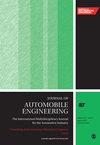半椭圆形弹簧尺寸变化对被动能量耗散影响的数值案例研究
IF 1.5
4区 工程技术
Q3 ENGINEERING, MECHANICAL
Proceedings of the Institution of Mechanical Engineers Part D-Journal of Automobile Engineering
Pub Date : 2024-07-26
DOI:10.1177/09544070241262352
引用次数: 0
摘要
本研究对板簧弧高尺寸变化对能量耗散和变形能的影响进行了参数评估。利用有限元软件包 Abaqus,通过改变弹簧弧高,在四种情况下建立离散模型,数值计算了压缩试验下板簧的循环力-位移曲线,随后计算了能量耗散和势能。通过对商用弹簧进行压缩试验,对离散模型进行了实验验证。结果表明,改变弧高会影响能量耗散和势能的大小。据观察,通过将弧高降低 33%,能量耗散增加了 50%,势能增加了 3%,与原始模型相比,比阻尼能力增加了 47%。从离散模型中得出的结论是,当弧线高度降低 33% 时,接触压力、接触面积和滑移区域的分布更加均匀,此外,弹簧的质量也有所降低,这些结果可能对汽车悬架设计人员有用。本文章由计算机程序翻译,如有差异,请以英文原文为准。
Numerical case study of the influence of dimensional variation of a semi-elliptic spring on the passive energy dissipation
In this work the parametric evaluation of the influence of the dimensional variation of the arc height of a leaf spring on the energy dissipation and deformation energy is presented. With the use of the finite element package Abaqus, the cyclic force-displacement curve of the leaf spring under a compression test was numerically obtained through a discrete model for four cases, by varying the arc height of the spring, subsequently the energy dissipation and the potential energy was calculated. The discrete model was experimentally validated by performing compression tests on a commercial spring. The obtained results show that varying the arc height influences the amount of energy dissipation and potential energy. It was observed that by decreasing the arc height by 33%, the energy dissipation increased by 50% and the potential energy by 3%, resulting in an increment in the specific damping capacity of 47% with respect to the original model. From the discrete model, it is concluded that the contact pressure, contact area, and slip zones are more uniformly distributed when the arc height is reduced by 33%, besides of a decrease in the mass of the spring, results which may be useful for car suspension designers.
求助全文
通过发布文献求助,成功后即可免费获取论文全文。
去求助
来源期刊

CiteScore
4.40
自引率
17.60%
发文量
263
审稿时长
3.5 months
期刊介绍:
The Journal of Automobile Engineering is an established, high quality multi-disciplinary journal which publishes the very best peer-reviewed science and engineering in the field.
 求助内容:
求助内容: 应助结果提醒方式:
应助结果提醒方式:


